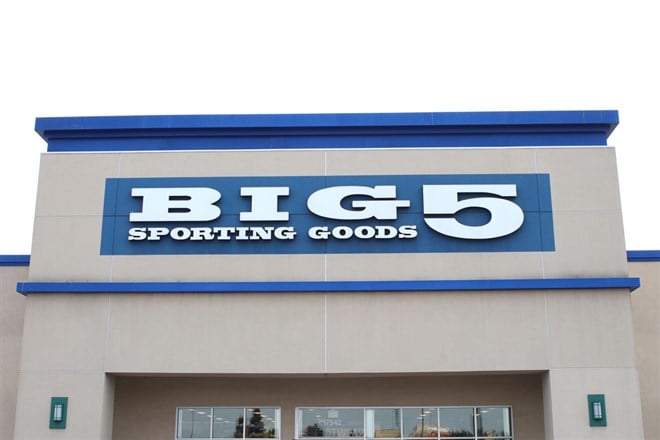Is Big 5 Sporting Goods Stock Finally Putting in a Bottom? Regional sporting goods retailer Big 5 stock doesn't reflect the relative strength of its peer sporting group stocks. Net income continued to fall in 2022.
By Jea Yu
This story originally appeared on MarketBeat


Regional sporting goods retailer Big 5 Sporting Goods Corporation (NASDAQ: BGFV) stock doesn't reflect the relative strength of its peer sporting goods and apparel companies. Big 5 stock is the worst-performing of the group of sports retailers led by DICK'S Sporting Goods Inc. (NYSE: DKS), Hibbett Inc. (NASDAQ: HIBB) and Foot Locker Inc. (NYSE: FL). It's the weakest of the bunch due to its -9.8% same-store sales comparables for Q3 2022 and a lowered Q4 2022 EPS guide.
The company declared a large 10.88% annual dividend, or $0.25 per share quarterly dividend. The company experienced macroeconomic headwinds that accelerated in its fiscal third quarter, especially compared to the strong record-setting year-ago third-quarter results. Those sales surged due to pandemic-related factors and the pent-up demand during the reopening of schools and sports leagues. The normalization is very apparent when compared to year-ago periods. Net income fell 75% year-over-year (YOY) in the third quarter, from $24.1 million in Q3 2021 to $6.4 million in Q3 2022.
Still Better Off than Pre-Pandemic
Now that normalization has set in, the company insists that sales trends still exceed pre-COVID levels. The company noticed a decline in consumer sentiment during the quarter. Customers were still buying the required sports equipment to play on teams but holding off on buying that extra pair of shoes or apparel. Supply chain constraints continued in the quarter, causing margins to fall 132 basis points.
Earnings Still in the Black
On November 1, 2022, Big 5 released its fiscal third quarter 2022 results for September 2022. The company reported an earnings per share (EPS) profit of $0.29, beating estimates by $0.02. Net income was $6.4 million compared to a whopping $24.1 million in the year-ago period. Revenues fell 9.7% YOY to $261.45, which still beat analyst expectations of $258.41 million. Sales comps were tough against a banner Q3 2021 as same-store sales dropped 9.8% YOY.
Big 5 CEO Steven Miller commented, "Taking a step back, our model has been tested in a wide range of economic cycles over many decades. While this cycle will certainly be memorable with its intense challenges, our playbook remains the same, use the flexibility of our model to our advantage, look to optimize gross profit dollars and relentlessly focus on the areas of expense management that we can control."
Keeping the Bar Low
The company lowered its Q4 2022 guidance, assuming the macroeconomic headwinds continue. It dropped its EPS guidance between $0.08 to $0.20 versus a $0.29 single analyst estimate. It still expects same-store sales to tumble in the high single-digit- to the low-double-digit range. Investors hope the company is overly cautious with guidance to set the bar low enough to bear estimates if the normalization overshot itself. Judging by its peers, it may have.
Weekly Descending Triangle Breakdown
The Big Five weekly candlestick chart shows a descending triangle pattern that started in April 2022 and broke through the flat lower support under $10.06. October through November, Big Five shares rose above the triangle falling trendline as it appeared a breakout was on its way as shares popped as high as $13.86 before putting in a market structure high (MSH) sell trigger under $12.33. As shares folded back down, they gained momentum that crashed right through the flat triangle support and made a new swing low at $8.36. The weekly stochastic fell through the 20-band.
The weekly 20-period exponential moving average (EMA) resistance has started to descend again at $11.30, followed by the weekly 50-period MA at $13.18. After five straight red weekly candles, a market structure low (MSL) formed on the higher low green candle. The MSL buy triggers above the high of that MSL higher low green candle at $9.28. The weekly stochastic would have to cross back up to sustain any bounce that will retest the triangle and falling 20-period EMA. Pullback supports from here sit at $8.36 swing low, $7.75, $7.41, $6.84 and $6.40.









